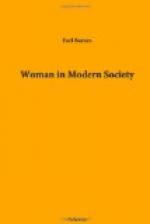Meantime, there have been no important reactions in institutions which have once opened their doors to women.[22] In 1902, Chicago University separated men and women students, but only during the first two years of their undergraduate work. Practically this has affected only one-half of the women in the first year and a very much smaller proportion in the second year.[23] When Leland Stanford Junior University was opened in 1891, 25.4% of the students were women. This proportion rose in successive years as follows: 1892, 29.7%; 1893, 30.4%; 1894, 33.8%; 1895, 35.3%; 1896, 36.6%; 1897, 37.4%; 1898, 40.1%. Fearing that the institution would be swamped with women, and that able men students would stay away, Mrs. Stanford ruled that there should never be more than five hundred women students in the university at one time. This limit was reached in 1902, and it was then provided that women should not be received as special students, nor in partial standing. Later, men in partial standing were cut out, though they continued to be received as special students. Women are now admitted in order of application, but preference is given to juniors and seniors. This really establishes a higher standard for women than for men, and one would expect that men would be kept away from an institution requiring a higher standard for women quite as much as from one where there were many women working on an equality with men. In 1910, Tufts College decided to separate men and women, for local reasons. The statement was made at the time that a philanthropist had promised a gift of $500,000 for a woman’s college, if the sexes were separated.[24] The doors of Wesleyan are to be closed to women after 1912, but this is due to local and financial reasons.
[22] HELEN R. OLIN, The Women of a State University, G.P. Putnam’s Sons, 1909.
[23] MARION TALBOT, The Education of Women, University of Chicago Press, 1910.
[24] Report of the United States Commissioner of Education, p. 132, 1910.
The movement in European universities, while not so uniform as in America, has been in the same direction. Miss Buss, Miss Beal and Miss Emily Sheriff led an early movement for higher secondary education of girls similar to that which gathered around Miss Willard in America. In 1871, Miss Clough started in England the lectures for women which led to the establishment of Newnham and Girton at Cambridge, and opened Oxford to women. Now women can study almost any subject they like at these universities and take the same examinations as the men. They do not receive degrees, but they have most of the other advantages of men, and for forty years they have carried off many honors. In the newer universities of London, Manchester, Leeds, Liverpool and in the Welsh University they have every advantage open to men.
In Germany, the opportunities for higher education of women have changed from year to year; but in 1910, there were 1,856 women in the universities as compared with 1,108 in 1909, and this notwithstanding the Emperor’s well known belief that woman’s sphere should be limited to domestic activities.




